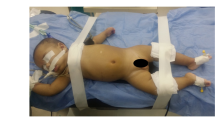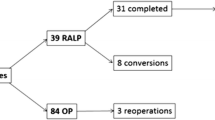Abstract
Aim
Laparoscopic pyeloplasty (LP) is a minimally invasive approach that is becoming a standard treatment of ureteropelvic junction obstruction (UPJO). It is providing similar results when compared with open surgery. We here present our technique and analyses of experience of our first 100 cases.
Patients and methods
We retrospectively reviewed and analyzed the records of first 100 cases of LP performed for UPJO with dilatation of renal pelvis at our centre. Patients’ profile; perioperative, intraoperative and postoperative parameters like time of surgery, blood loss, complications, duration of hospital stay, outcome of procedure were analyzed.
Results
The mean operative time, need for an extra-port, conversions to open, estimated blood loss, complications and recurrences all significantly decreased after first 50 cases. One patient developed shock due to bleeding from inferior epigastric vessels near port-site, and had to be explored. Overall success rate was 96%. Lesser incidence of fourth-port insertion, conversions to open, and thus decreased operative time was attributed to introduction of additional techniques to reduce the learning curve.
Conclusion
LP is a technically difficult procedure. Sticking to the basic steps of LP, and trying and thus incorporating additional tactics are useful to reduce the learning curve.


Similar content being viewed by others
References
Jarrett TW, Chan DY, Charambura TC et al (2002) Laparoscopic pyeloplasty: the first 100 cases. J Urol 167:1253–1256
Calvert RC, Morsy MM, Zellhof B, Rhodes M, Burgess NA (2008) Comparison of laparoscopic and open pyeloplasty in 100 patients with pelvi-ureteric junction obstruction. Surg Endosc 22:411–414
Klingler HC, Remzi M, Janetschek G et al (2003) Comparison of open versus laparoscopic pyeloplasty techniques in treatment of uretero-pelvic junction obstruction. Eur Urol 44:340–345
Türk IA, Davis JW, Winkelmann B (2002) Laparoscopic dismembered pyeloplasty: the method of choice in the presence of an enlarged renal pelvis and crossing vessels. Eur Urol 42:268–275
Eden CG (2007) Minimally invasive treatment for ureteropelvic junction obstruction: a critical analysis of results. Eur Urol 52:983–989
Wagner S, Greco F, Inferrera A, Hoda MR, Kawan F, Hamza A et al. (2009) Laparoscopic dismembered pyeloplasty: technique and results in 105 patients. World J Urol. doi:10.1007/s00345-009-0483-0
Rassweiler JJ, Teber D, Frede T (2008) Complications of laparoscopic pyeloplasty. World J Urol 26:539–547
Neulander EZ, Romanowsky I, Assali M, Klain J, Lissmer L, Kaneti J (2006) Renal pelvis flap-guide for ureteral spatulation and handling during dismembered pyeloplasty. Urol 68:1336–1338
Mandhani A, Goel S, Bhandari M (2004) Is antegrade stenting superior to retrograde stenting in laparoscopic pyeloplasty? J Urol 171:1440–1442
Srivastava A, Singh P, Gupta M, Ansari MS, Mandhani A, Kapoor R et al (2008) Laparoscopic pyeloplasty with concomitant pyelolithotomy – is it an effective mode of treatment? Urol Int 80:306–309
Ramakumar S, Lancini V, Chan DY, Parson JK, Kavoussi LR, Jarrett TW (2002) Laparoscopic pyeloplasty with concomitant pyelolithotomy. J Urol 167:1378–1380
Agarwal A, Varshney A, Bansal BS (2008) Concomitant percutaneous nephrolithotomy and transperitoneal laparoscopic pyeloplasty for ureteropelvic junction obstruction complicated by stones. J Endourol 22:2251–2255
Nguan C, Girvan A, Luke PP (2008) Robotic surgery vs laparoscopy: a comparison between two robotic systems and laparoscopy. J Robot Surg 1:263–268
Gettman MT, Peschel R, Neururer R, Bartsch G (2002) A comparison of laparoscopic pyeloplasty performed with the daVinci robotic system versus standard laparoscopic techniques: initial clinical results. Eur Urol 42:453–457
Erdeljan P, Caumartin Y, Warren J et al (2008) Robotic pyeloplasty: long-term follow-up of first Canadian experience. CUAJ 2:309
Desai MM, Rao PP, Aron M, Pascal-Haber G, Desai MR, Mishra S et al (2008) Scarless single port transumbilical nephrectomy and pyeloplasty: first clinical report. BJU Int 101:83–88
Author information
Authors and Affiliations
Corresponding author
Rights and permissions
About this article
Cite this article
Singh, O., Gupta, S.S. & Arvind, N.K. Laparoscopic pyeloplasty: an analysis of first 100 cases and important lessons learned. Int Urol Nephrol 43, 85–90 (2011). https://doi.org/10.1007/s11255-010-9753-4
Received:
Accepted:
Published:
Issue Date:
DOI: https://doi.org/10.1007/s11255-010-9753-4




